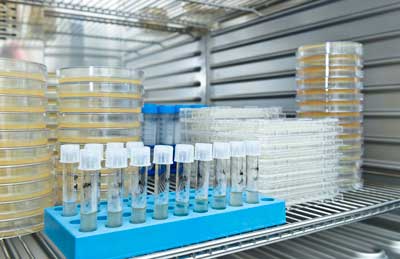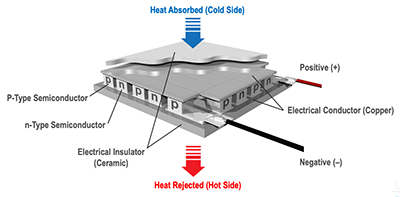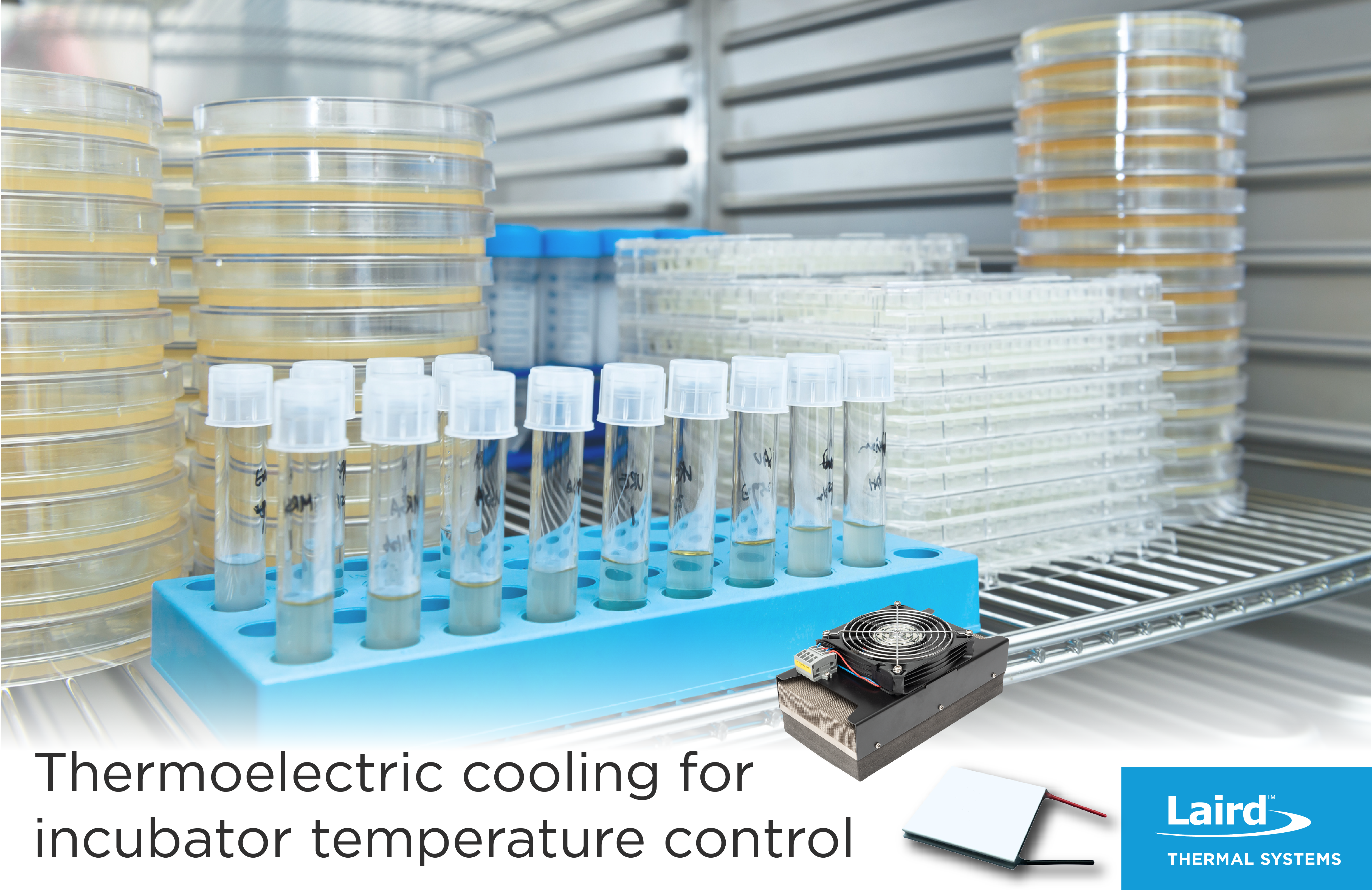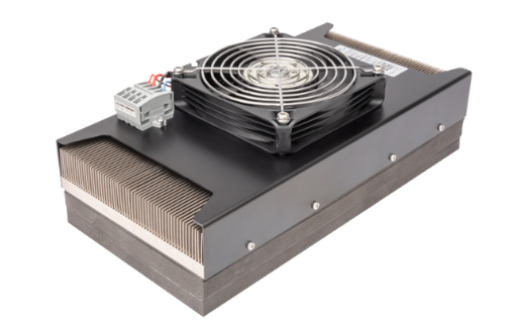Introduction
Incubators, used for cell and tissue cultivation in hospital and laboratory settings, grow and maintain cell and tissue samples under controlled conditions for hours, weeks, or even months. They create the ideal environment for cell and tissue sample growth by maintaining optimum levels for temperature, humidity, carbon dioxide, and oxygen. Precision control of these factors enables research and experimental work in industries where cell culture is vital, such as zoology, microbiology, pharmaceutical research, food science, and cosmetics.
Accurate and precise control of temperature is especially important for cell growth. Excursions above and below the optimum mammalian body temperature of 37°C, even by as little as 6°C, negatively impact cell health. If too cold, growth slows, sometimes permanently; if too hot, sensitive proteins begin to denature.
Using thermoelectrics instead of compressor-based thermal management solutions provide a more efficient and cost-effective option. In addition, new government restrictions of traditional refrigerants central to compressor-based systems make thermoelectrics a more environmentally friendly solution for temperature stabilization in incubators.
Incubator Requirements
Control of temperature, humidity, carbon dioxide, and oxygen levels must be maintained in the incubators for proper cell culture to occur. The heat load requirements can range from 30 to more than 400 Watts based on chamber size. For CO2 incubators, relative humidity levels of 95 to 98 percent and specified CO2 concentrations ranging from 0.3 to 19.9 percent also must be maintained.

Design Challenges
Incubator manufacturers face many thermal management design challenges ranging from space constraints, airflow, moisture, and dust, to ease of cleaning.
Dependent on the cabinet size the chamber will require a specific amount of cooling capacity to reach worst case cool down temperature. The higher the cooling capacity, the larger the cooling unit needs to be. However, the thermal solution must include an efficient heat exchanger with a thin profile that can operate in a confined space to maximize chamber volume. Therefore, thermal control units in space constrained incubators need to have high performance heat exchangers in order to reach the higher cooling capacity requirements.
Another challenge is ensuring consistent airflow throughout the chamber. Incubators feature fans to circulate air within the chamber. To minimize variability between samples they use air ducted shrouds to distribute air evenly throughout chamber. However, operating in a high humidity environment requires fans and other components to be protected from moisture that can cause corrosion and quickly degrade the performance of mechanical components. It can be difficult, however, to balance the high humidity levels needed for proper operation of the incubator with condensation forming inside the unit. Features such as gasket sealing, insulation, potting and routing of condensation can limit exposure to moisture degradation.
From an operational standpoint, dust environment in labs may be a concern. Depending on lab activity around where the incubator is stationed, dust can accumulate over time in the heat exchanger assembly and increase the thermal resistance. This will reduce performance and make the thermoelectric assembly work harder to achieve the same set point temperature. To maintain good thermal performance over time, it is ideal to keep air inlet away from the floor and consider using an air filter to capture dust from incoming air. The incubator design also must account for biohazard safety protocols by incorporating easy-to-clean and sterilize interiors and shelves. This may require the cooling unit to withstand elevated temperatures during the sterilization process.
Traditional Solutions
Typically, in a CO2 incubator, an air or water jacket maintains an even temperature. Since water has a much greater specific heat than air, water temperature changes much more slowly, thereby regulating the temperature inside the lab incubator. The water jacket, a water-filled casing surrounding the incubator, has inlet and outlet ports which circulate water through the chamber walls and to an external heating and/or cooling device. The water exchanges heat with the inner chamber via natural convection and provides a fairly uniform interior temperature and thermal buffer against outside air. The down side is water jackets may leak; and since they contain a significant volume of water, they are very heavy and usually need to be emptied before moving. After moving, the refill and restart process requires about 24 hours to return to a stable operating temperature, leading to significant downtime.
Using a similar casing to the water design, an electric coil or compressor-based system heats air within the jacket, which radiates heat directly to the cell cultures. Some air-jacketed models rely strictly on natural convection to distribute heat evenly inside the chamber, while others add fans. Forced convection, however, increases evaporation from the cultures, desiccating small samples, even when adding a humidity pan. In addition, compressor-based air jackets add unwanted vibration and noise to the lab environment, while generally occupying a large amount of space.
Recent government regulations restricting the use of specific refrigerants, particularly in Europe, are motivating incubator manufacturers to look at solid-state thermoelectric temperature control systems as an alternative to compressor-based systems. Older compressor-based systems utilize high global-warming-potential HFC refrigerants including R134a and R404A. Modern compressor-based systems now use a variety of natural refrigerants: R744 (carbon dioxide), R717 (ammonia), R290 (propane), R600a (isobutene), and R1270 (propylene). Each natural refrigerant, however, presents design challenges such as increased pressure, high toxicity, flammability, asphyxiation, and relatively poor performance. The flammable nature of some natural refrigerants makes them hazardous to transport and limits capacity.
Peltier Heating/Cooling
Environmentally friendly thermoelectric temperature control systems offer accurate and precise heating and cooling inside the chamber in a compact form factor. There are many advantages of using thermoelectrics for thermal management including cooling or heating modes, precise temperature control and rapid cool-down or heat-up ramp rates. They also keep samples safe from temperature changes. All of this is accomplished without the use of any refrigerants—natural or synthetic.
Thermoelectric coolers are solid-state heat pump devices which move heat via the Peltier effect. During operation, DC current flows through the thermoelectric cooler creating temperature differential across the module. While one side of the thermoelectric cooler gets cold (heat absorption), the other side heats up (heat dissipation). Thermoelectric coolers usually connect to forced convection heat sinks to the cold side to absorb heat from inside the cabinet, while the hot side heat sink rejects heat to ambient environment. By reversing the polarity of the thermoelectric cooler, it can also heat inside the cabinet. The ability to both heat and cool allows for precise temperature control.

Thermoelectric coolers remove heat by utilizing the Peltier Effect.
Manufacturers of thermoelectric coolers define two specifications for thermoelectric coolers: ΔTMax and QcMax. ΔTMax is the maximum temperature differential with no heat flow (Qc = 0). QcMax is the maximum heat flow when no temperature difference exists (ΔT = 0). For most single-stage thermoelectric coolers, ΔTMax hovers near 70°C. However, a lot of this temperature differential can be lost thru thermal resistances of heat sinks. If greater cooling capacity is demanded, then more thermoelectric coolers are required. This can be done by wiring thermoelectric coolers in series or parallel to accommodate 12 or 24 VDC. Real-world operation of thermoelectric coolers and thermoelectric cooler assemblies involves the combination of ΔT and Qc to meet incubator heating and cooling requirements for temperature stabilization.
Thermoelectric cooler assemblies are compact units that allow design engineers to start with a basic set of building blocks mating fans and thermoelectric coolers to heat exchangers. They have a cooling capacity spectrum ranging from 10 to 400 Watts and are available in convection, conduction, or liquid heat transfer mechanisms.
Below is an illustration on how a typical thermoelectric heater/cooler assembly is used to cool or heat an incubator chamber. The thermoelectric unit is mounted between two air heat exchangers. In cooling mode, air inside the chamber circulates across the cold side air heat sink and gets cold. The thermoelectric cooler absorbs the heat and pumps it out to the hot side heat sink. The hot side air heat exchanger circulates air to the ambient environment. In heating mode, the opposite occurs. To limit heat transfer to the ambient environment, the hot side fan is typically off in heating mode.

The combination of a closed-loop temperature controller with a thermoelectric cooler assembly creates a highly responsive, accurate and precise thermal management system. A temperature controller, specifically designed to control thermoelectric cooler assemblies, takes feedback from a temperature sensor to vary the output of the power supply to control the temperature of an enclosure. Temperature controllers can accommodate a variety of control options to deliver energy savings and offer safety alerts. I/O contacts are available for fans, thermoelectric coolers, alarm/status LEDs, thermistors, fan tachometer sensors, and an overheat thermostat.
Laird Thermal Solutions for Incubators
Laird Thermal Systems produces a wide array of thermoelectric coolers, assemblies and temperature controller combinations optimized for this application.
Assembled with advanced thermoelectric materials, the new HiTemp ETX Series of thermoelectric coolers offers a 10% boost in cooling capacity compared to standard thermoelectric coolers. It also features a higher thermal insulating barrier, creating a maximum temperature differential (ΔT) of 83°C. The HiTemp ETX thermoelectric cooler is designed for high-temperature environments and for applications where both heating and cooling is required such as incubators. Learn more about the HiTemp ETX series.

Laird Thermal Systems HiTemp ETX Series
Another option is any of the SuperCool X thermoelectric cooler assembly series outfitted with a SR-54 or PR-59 temperature controller. All options feature a high-performance heatsink design, incorporating heat pipes to improve heat dissipation and fan shroud assembly. Lowering the thermal resistance of the heat exchanger increases the heat-pumping ability, so these thermoelectric cooler assemblies can operate at a higher coefficient of performance (COP), reducing power consumption relative to competing technologies. The SuperCool X series utilizes next-generation high-performance thermoelectric coolers, offering up to a 20% improvement in cooling capacity compared to the legacy edition. All this capability is packed into a compact form factor.
The Series gives design engineers three different heat transfer mechanisms with three standard thermoelectric cooler assemblies: Liquid-to-Air, Direct-to-Air, or Air-to-Air. These assemblies offer cooling capacities of 115 to 407 Watts when measured at ΔT = 0°C with a nominal operating voltage of 24 VDC. They can be easily mounted onto vertical walls using fastening machine screw hardware. Learn more about the SuperCool X Series of thermoelectric cooler assemblies.

SuperCool X Series: SAAX-175-24-22, SDAX-220-24-02, SLAX-215-24-02
Combining a SuperCool X Series thermoelectric cooler assembly with a temperature controller offers significant design advantages over traditional technologies. The SR-54 programmable microcontroller provides thermal stability to within ±0.13°C of the set point in both heating and cooling modes. This controller allows the incubator to reach the set-point temperature quickly without overshooting. Its monitoring capabilities track potential issues, including problematic fans, thermoelectric coolers, and thermostats for quick fault troubleshooting, maximizing incubator uptime. Variable fan speed reduces operational noise since the fans only run on high speed during the initial temperature ramp and then lower their speed when the incubator temperature has reached steady-state.
Another option is the PR-59 temperature controller with power regulation that is selectable and user-configurable for PID (proportional-integral-derivative), thermostat ON/OFF, or POWER, protecting equipment and optimizing performance. The PR-59 programmable microcontroller delivers control stability to within ±0.05°C of the set point in both heating and cooling modes. By connecting to a PC with associated software, temperature set points and other parameters can be selected. Learn more about temperature controller options here.

SR-54 and PR-59 Temperature Controllers
Laird Thermal Systems can customize thermoelectric solutions based on specific application needs. Customers usually begin with a standard thermoelectric cooler assembly and adjust the form factor by modifying heat sinks, mounting locations, and air flow passages to work around obstructions. Barrier protection around the thermoelectric cooler cavity prevents condensation issues from impacting thermoelectric cooler assembly operation. Laird Thermal Systems understands how to modify designs to boost performance or efficiency, optimizing for the desired thermal-management effect. Many years of experience have stocked a large library with reference designs for similar applications, enabling quick response with new custom designs.
Conclusion
Using thermoelectrics for incubator temperature control, rather than traditional technologies, achieves an efficient, thermally stable, compact, reliable, low-maintenance and low-cost-of-ownership solution to CO2 incubator thermal management.
Laird Thermal Systems can partner closely with customers across the entire product development lifecycle to reduce risk and accelerate time to market. Depending on the customers' needs they can provide various levels of vertical integration. Some customers purchase Laird Thermal Systems’ thermoelectric cooler assemblies and build their own custom solutions while others design their own solutions and use Laird Thermal Systems as a contract manufacturer to build them. Still, others prefer the entire solution, from design to manufacturing.
CONTACT US for further insights.




